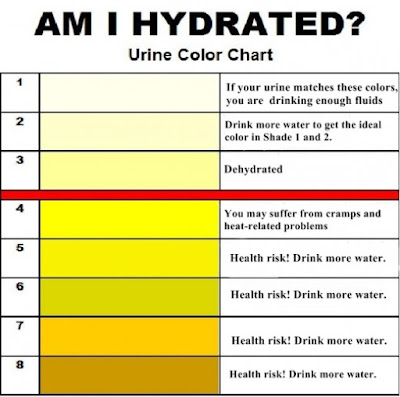 |
Photo credit: momsteam.com |
Do you know what the color of your urine says about your health? Urine can change in color in few minutes and this can be determined by what you ate recently, the medications you are taking, if you are dehydrated, infections and even some certain cancers. Urine offers telltale signs of what's going on inside the body. So before your flush that pee out, learn more about the colors of urine and what they tell us.
Discover what color is normal, the colors to look out for, and how the quantity of water you consume can affect your health.
HOW THE URINE JUMPS OUT
Before we go further, you should know the urinary tract consists of four parts: the kidneys, ureters, bladder and urethra. Urine flows from the kidneys, down via the ureters, and straight into the bladder. The bladder is like a storing tank for urine, where it relaxes waiting to be pumped out through the urethra.
WHAT COLOR IS YOUR URINE?
Your wee/pee can tell a whole lot of story about your health and hydration. Depending on what you eat, medication and hydration, note that the urine can temporarily change colors. On rare occasions, some medications and foods can make your urine look green, or even blue.
WHAT YOUR PEE MIGHT BE TELLING YOU:
Transparent-Yellow Pee: This should be the color of your urine if you are healthy, and well-hydrated.
Transparent Or Clear Pee: This appears when you drink too much of water. Drinking too much of water makes the urine colorless. This is also called overhydration, though initially harmless, but can lead to serious complications if it happens for long periods.
Dark Yellow Pee: It is still "normal" but nearing dehydration. You should start to sip water more regularly.
Honey-Colored Pee: Time to increase water consumption.
Maple-Syrup-Colored Pee: Chai! This could be as a result of severe dehydration or liver disease.
Pink To Reddish-Colored Pee: It could be that you have been eating red-pigmented foods like blueberries. If so, you are probably okay. If not, there may be blood in your urine. This could be a sign of urinary tract or kidney infection; kidney stones; or cancer of the kidney, bladder or prostrate. You should visit your primary health care centre immediately to get checked.
Foamy Or Fizzy Pee: If this occur on rare occasions, then you are good to go. But if it occurs every time you pee, it could mean high protein is present in your urine, which may require you get checked by your doctor.
GET RID OF THAT CLEAR PEE
Truly, water is essential in keeping the body organs running, and drinking water consistently helps regulate the body temperature, clears the bowels, removes waste products and keeps the skin glowing.
And that's just few of the advantages of drinking water.
Although dehydration gives room for more worry than overhydration, many people tend to drink more water than they need. A normal healthy pee has a yellow color from a pigment called urochrome. The darker the yellow color of the urine becomes, the less hydrated the body is. However, too much intake of water that your pee becomes clear can cause imbalance in the electrolyte levels.
Blood intoxication, also know as hyponatremia occurs from the disruption of the natural balance between water and sodium in the blood. This can occur when we carry out a physical task, thereby sweating excessively and taking too much of water. Water overload without the replacement of sodium in the body can result to blood sodium concentration that falls below normal level.
Common symptoms of hyponatremia include:
- Nausea and vomiting
- Headache and confusion
- Fatigue
- Muscle weakness, spasms or cramps
- Seizure or convulsions
- and even coma
Hyponatremia is known to be one of the most common electrolyte abnormalities. A good key to preventing overhydration is to sip (drink lightly, not excessive) water throughout the day, and to take in about half your bodyweight in ounces of water per day. For instance, a 180-pound man should take in about 90 ounces of water per day.
DARK COLOR IS NOT GOOD FOR YOU
Dehydration is the result of greater loss of body fluids than intake. You should increase water intake if your pee looks a bit dark. Remember, sip (not gulp) water all day.
Other signs of dehydration aside from darkening urine include:
- Fatigue, excessive yawning
- Moodiness
- Lack of concentration
- Dry mouth and skin
- Headaches
- Constipation
Hypernatramia, a severe dehydration case is the opposite of hyponatremia, and it caused by the presence of excess sodium. This only occurs when there is water deficiency. You can lose a lot of water over long periods of physical activities, or with certain illnesses and medication.
To combat dehydration, drink a sports drink (e.g. Lucozade sport) that will rebalance your electrolytes and inject sodium back into your body system. Be wary of working in hot weather or in facilities without proper air conditioning.
I hope this helps. Stay healthy!
Source: bodybuilding.com
Comments